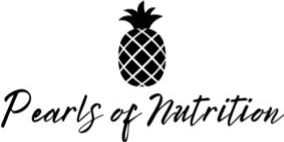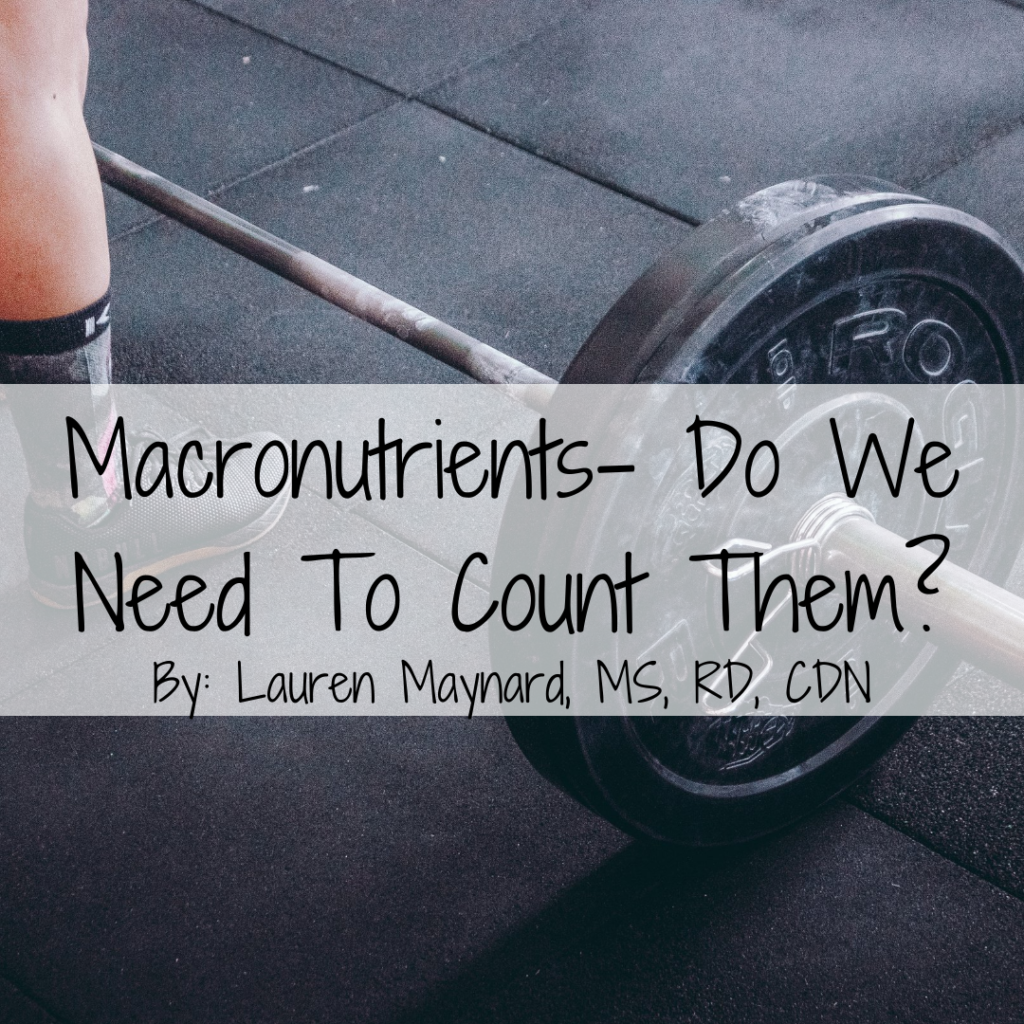I don’t know about you but the thought of having to track “macros” makes me cringe a little, and this is coming from a dietitian. Most of my education and training was based around tracking and calculations. Don’t get me wrong, I love a good calculation but it is not something anyone needs to spend time doing to support a healthy lifestyle.
Macronutrients or “macros” are the nutrients we consume in the largest quantity that support energy and overall body function. They consist of carbohydrates, protein and fat. Micronutrients are vitamins and minerals, which won’t be focused on heavily in this post. As to diet culture’s dismay, we do actually need all three macronutrients. Yes, even carbs. You have likely heard of one trend or another, where one of the above macronutrients was deemed unhealthy and should be removed. That creates a lot of confusion around food and considering how the demonized macro keeps changing, you should be skeptical.
Overview of Macronutrients & Their Function
Carbohydrates
Despite popular diet persuasions [that’s you Keto, Atkins, low-carb diets], carbohydrates or “carbs” are truly what our body prefers to use for energy on a daily basis. When I say energy, I mean how our body is able to wake up and brush our teeth, go about our jobs, support exercise/movement and also how we keep our internal organs alive and well. Through adequate consumption of carbohydrates, we are able to keep a constant supply of energy available in our bloodstream and/or store what we don’t need for later use. Carbohydrates are stored as glycogen in our liver and muscles. No other macronutrient has this capability! The stored version of carbohydrates become really useful when we consider supporting our body during exercise. Our muscles break down the glycogen they have stored for immediate use.
Foods such as grains (rice, quinoa, amaranth, grits), wheat products (flour, pasta, bread, crackers, etc.), starchy vegetables (potatoes, corn, peas, lima beans, winter squash), fruits, dairy, and legumes (beans, lentils) are great sources of carbohydrates.
Protein
We typically associate protein with muscle growth, which is absolutely true but there’s also more to the story. Our body’s first priority is to have enough energy. In order to move on to consider muscle repair/growth, we need to ensure our energy supply is adequate. This happens only if we simultaneously consume an adequate amount of energy which is difficult to do without sufficient carbohydrates. If we continuously lack or restrict carbohydrates, protein can be forced into giving us energy instead and we then cannot use the protein for muscle growth or general body maintenance. Seems non-productive and gives us one more reason to love carbs!
Outside of muscle maintenance and growth, protein is really important for metabolic, hormonal and immune function. Out of all three macronutrients, protein tends to be the least worrisome and easiest to achieve adequate amounts, provided you include animal proteins of some sort in your diet. The timing of protein and post-workout protein consumption is something we will talk more about later on.
Sources of protein can range from animal-based proteins (chicken, fish, beef, pork eggs, dairy products) or plant-based proteins (beans/lentils, tofu/soy products, nuts and seeds). Animal based sources of protein are more complete, containing all 20 amino acids, and easier for the body to absorb and utilize.
Fats
Fats are the most calorically dense macronutrient which makes them very unique and beneficial. Fats are essential for vitamin and mineral absorption, aiding in reducing inflammation, achieving satisfaction or satiation with meals and are a part of achieving a balanced diet overall.
Increasing Omega-3 fats such as fish, chia seeds, ground flaxseed, walnuts, olive oil and avocado can be great additions to your meals during the day, especially after your workout.
A bit about micronutrients
Even individuals who consume a balanced and varied diet can sometimes miss hitting recommended amounts of vitamins and minerals. Those who may restrict foods/food groups, regardless of if this is due to an eating disorder, personal preference, or allergy, are at a higher risk for developing nutrient deficiencies. This is especially true if your total energy intake is below your needs. We encourage working with a dietitian who can provide individualized recommendations to ensure you are meeting your micronutrient needs.
What if you feel tracking is beneficial?
I often find that the thought behind wanting to track macronutrients is to feel safe that you’re eating the “right” amount, or to provide structure to a diet. An important thing to remember is that our bodies are very smart and when we begin to listen to them regarding hunger, fullness, and satisfaction it makes a world of difference. Homo sapiens have existed and thrived for hundreds of thousands of years without counting calories or macros. In fact, calories weren’t even identified as a unit of energy until the early 1800s and we have only had cell phones with calorie and macro tracking apps since 2008. We can definitely thrive without counting, but this requires putting your phone down and tuning into your body.
Tracking macros, calories and steps can become exhausting and very restrictive. Working with a dietitian can help to offer guidance on what combinations of foods/food groups to enhance your diet and how to listen to your own body cues can help develop a positive relationship with movement and supportive nutrition!
General Macronutrient Recommendations for Active Individuals
- Each meal should include protein, carbohydrates, fat and produce. Eating every 3-4 hours with this variety, will allow you to better support your activity and recovery.
- Pre-workout nutrition should primarily consist of carbohydrates and a small amount of protein. If you have the time (1-4 hours before you workout) you may be able to have a bigger snack, such as yogurt and granola, eggs and toast, fruit and oatmeal/granola bar, fruit smoothie with yogurt. If you find that you only have 15-30 minutes, try something small like a few dates, a few sips of a sports drink or a small glass of juice, or a banana.
- Post-workout nutrition can be geared around consuming all macronutrients. This can look like a sandwich with bread, lunch meat/hummus and cheese or maybe a smoothie with protein powder or whole milk yogurt, frozen fruit/veggies, nuts/seeds/nut butters. Maybe it is time for your next meal and you can apply the same principles of balancing carbohydrates, protein, fat and produce together.
- REST! Rest, stretching and adequate sleep remain just as important as the activity you are doing. You wouldn’t expect your car to continue to run without maintenance, repair, and gas, and we shouldn’t expect that from our bodies.
*You may notice increased hunger on rest days. This is normal! Continue to honor these hunger cues just as you would on active movement days .
Higher Intensity or Longer Duration Exercise for Athletes and Competition Days
- If you are training for longer periods of time (>1-1.5 hours) consider a sports, gels, or jelly beans drink during your session to support adequate energy supply.
- Competition days likely require higher levels of nutrients that should be personalized for you.
- Hydration plus appropriate replenishment of sodium and other electrolytes is crucial in ongoing activity and recovery.
- Most recommendations will note the importance of eating carbohydrates ~24 hrs prior to an event but this can actually extend well into 72 hrs prior to competition!
- Try to spread your protein consumption over 4-5 meals/snacks rather than eating most of your protein all at one meal. This will allow your body to adequately support recovery and muscle protein synthesis (MPS) and insure you are able to absorb and utilize all the protein you take in.
- If you are 55 years of age or older, you may require a higher protein intake as muscle protein synthesis becomes harder to achieve alongside of pregressive muscle loss.
If you are navigating recovery for disordered eating or an eating disorder, exercise may not be a part of your recovery plan right now. Working with a dietitian and team who are experts in recovery can address how movement can best work for you. We’d love to work with you!



